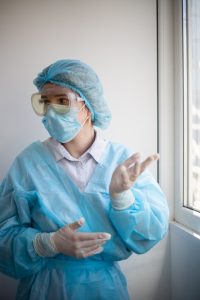2.5 Routine Practices and Personal Protective Equipment
Routine Practices
Routine practices are the IPC practices for use in the routine care of all clients at all times in all healthcare settings and are determined by the circumstances of the client, the environment and the task to be performed. This is often referred to medical asepsis or clean technique, used to describe measures for reducing and preventing the spread of organisms (Perry, Potter & Ostendorf, 2014).
Routine practices include:
- Point-of-care risk assessment (see section 2.6)
- Hand hygiene program (including point-of-care ABHR)
- Source control (triage, early diagnosis and treatment, respiratory hygiene, spatial separation)
- Client placement, accommodation, and flow
- Aseptic technique
- Use of PPE
- Sharps safety and prevention of bloodborne pathogen transmission
- Management of the client care environment
- Cleaning of the client care environment
- Cleaning and disinfection of non-critical client care equipment
- Handling of waste and linen
The routine precautions taken to prevent transmission of infectious micro-organisms are used in the care of all persons.
Routine Practices apply to all clients. They prevent the spread of infection from:
- Blood
- All body fluids, secretions and excretions (except sweat)
- Non-intact skin (skin with open breaks)
- Mucous membranes
ROUTINE PRACTICES OVERVIEW
Wash Hands
- Before handling client
- After contact with blood and/or bodily fluids or any contaminated items
- After gloves are removed
Wear Gloves
- When your hands are likely to come in contact with blood and/or bodily fluids and contaminate items
- For contact with mucous membranes and non-intake skin
- REMOVE gloves between clients
Client-care Equipment
- Hand client care equipment with care in order to prevent contaminating the environment (there maybe unknown sources of blood or bodily fluids)
Linen
- Place used and contaminated linen directly into the linen hamper
- Do not put used linen on the floor (spreads germs beyond the client’s environment)
- Keep dirty linen away from your body
Personal Protective Equipment (PPE)

Following routine practices and additional precautions involves the use of PPE. Personal protective equipment requires health care providers to wear gloves, gowns, and eye protection. Each agency/facility will have a policy and procedures for when and what types of PPE the healthcare staff should use. Donning (putting on) and Doffing (taking off) requires the provider to follow the proper order of putting on and taking of the PPE to ensure infection control. Figures 2.5.2 and 2.5.3 offer you the correct procedures for donning and doffing PPE.
While it is important to use Personal Protective Equipment when it is appropriate, it is equally important to know how to remove your PPE!
If you walk around the facility wearing any PPE (like gloves), you will spread germs


The following videos presented by the Provincial Infection Control Network of British Columbia (PICNET) demonstrate the techniques for Donning and Doffing PPE.
PPE Donning for Medical Mask by Learning Hub (2022) on YouTube
PPE Doffing for Medical Mask by Learning Hub (2022) on YouTube
Image descriptions
Putting on PPE
- Perform Hand Hygiene either by using alcohol-based hand rub or washing hands with soap and water (if hands are soiled).
- Put on Gown
- Tie neck and waist ties securely.
- Put on Mask or N95 Respirator
- Place mask over nose and under chin.
- Secure ties, loops, or straps.
- Mould metal piece to your nose bridge.
- For respirators, perform a seal-check.
- Put on Protective Eyewear
- Adjust eyewear to fit.
- Face shield should fit over brow.
- Put on Gloves
- Put on gloves, taking care not to tear or puncture the gloves.
- If a gown is worn, the glove fits over the gown’s cuff.
[Back to Figure 2.5.2]
Taking off PPE
- Remove Gloves
- Use glove to glove, skin-to-skin technique.
- Grasp outside edge near the wrist and peel away, rolling the glove inside-out.
- Reach under the second glove and peel away.
- Discard immediately into waste receptacle.
- Remove Gown
- Remove gown in a manner that prevents skin or clothes contamination.
- Starting at the neck ties, the outer, ‘contaminated’, side of the gown is pulled forward and turned inward, rolled off the arms into a bundle, then discarded immediately in a manner that minimizes air disturbance.
- Perform hand hygiene either by using alcohol-based hand rub or washing hands with soap and water (if hands are soiled).
- Remove Eye Protection
- Arms of goggles and headband of face shields are considered to be clean and may be touched with the hands.
- The front of goggles or face shield is considered to be contaminated.
- Remove eye protection by handling ear loops, sides or back only.
- Discard into waste receptacle or into appropriate container to be sent for reprocessing.
- Personally-owned eyewear may be cleaned by the individual after each use.
- Remove Mask or N95 Respirator
- Ties, ear loops, or straps are considered to be clean and may be touched with the hands.
- The front of the mask or respirator is considered to be contaminated.
- Untie bottom tie, then the top tie, or grasp straps or ear loops.
- Pull forward off the head, bending forward to allow the mask or respirator to fall away from the face.
- Discard immediately into waste receptacle.
- Perform hand hygiene either by using alcohol-based hand rub or washing hands with soap and water (if hands are soiled).
[Back to Figure 2.5.3]

